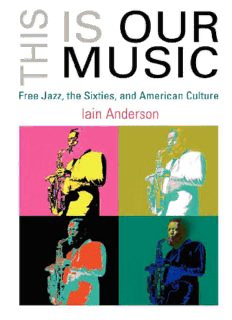
This Is Our Music: Free Jazz, the Sixties, and American Culture PDF
Preview This Is Our Music: Free Jazz, the Sixties, and American Culture
This Is Our Music PAGEi .................16065$ $$FM 01-13-1115:38:06 PS THE ARTS AND INTELLECTUAL LIFE IN MODERN AMERICA CaseyNelsonBlake,SeriesEditor Volumesintheseriesexplorequestionsattheintersectionofthehistory ofexpressivecultureandthehistoryofideasinmodernAmerica.The seriesismeantasaboldinterventionintwofieldsofculturalinquiry.It challengesscholarsinAmericanstudiesandculturalstudiestomove beyondsociologicalcategoriesofanalysistoconsidertheideasthathave informedandgivenformtoartisticexpression—whetherarchitecture andthevisualartsormusic,dance,theater,andliterature.Theseries alsoexpandsthedomainofintellectualhistorybyexamininghow artisticworks,andaestheticexperiencemoregenerally,participatein thediscussionoftruthandvalue,civicpurposeandpersonalmeaning thathaveengagedscholarssincethelatenineteenthcentury. AdvisoryBoard:StevenConn,LynnGarafola,CharlesMcGovern, AngelaL.Miller,PennyM.VonEschen,DavidM.Scobey,andRichard Ca´ndidaSmith. PAGEii .................16065$ $$FM 01-13-1115:38:06 PS This Is Our Music Free Jazz, the Sixties, and American Culture IAIN ANDERSON UniversityofPennsylvaniaPress Philadelphia PAGEiii .................16065$ $$FM 01-13-1115:38:08 PS Copyright(cid:2)2007UniversityofPennsylvaniaPress Allrightsreserved PrintedintheUnitedStatesofAmericaonacid-freepaper 10 9 8 7 6 5 4 3 2 1 Publishedby UniversityofPennsylvaniaPress Philadelphia,Pennsylvania19104-4112 LibraryofCongressCataloging-in-PublicationData Anderson,Iain,1967– Thisisourmusic:freejazz,thesixties,andAmericanculture/IainAnderson p. cm.—(TheArtsandintellectuallifeinmodernAmerica) ISBN-13:978-0-8122-3980-5(cloth:alk.paper) ISBN-10:0-8122-3980-6(cloth:alk.paper) (Contents:Theresurgenceofjazzinthe1950s—Freeimprovisationchallenges—thejazz canon—Freejazzandblacknationalism—Themusiciansandtheiraudience—Jazzoutside themarketplace.) Includesbibliographicalreferencesandindex. 1.Freejazz—UnitedStates—Historyandcriticism. 2.Jazz—Socialaspects— UnitedStates. 3.AfricanAmericanjazzmusicians. 4.BlackArtsmovement. I.Title. II.Series ML3508.A53 2006 781.65(cid:2)5—dc22 2006048961 PAGEiv .................16065$ $$FM 01-13-1115:38:08 PS Contents Introduction 1 1. TheResurgenceofJazzinthe1950s 10 2. FreeImprovisationChallengestheJazzCanon 49 3. FreeJazzandBlackNationalism 93 4. TheMusiciansandTheirAudience 122 5. JazzOutsidetheMarketplace 153 Epilogue 182 Notes 191 Bibliography 227 Index 239 Acknowledgments 253 PAGEv .................16065$ CNTS 01-13-1115:38:09 PS This page intentionally left blank Introduction In the summer of 1960, jazz composer and alto saxophonist Ornette Coleman,trumpeterDonCherry,bassistCharlie Haden,anddrummer EdBlackwellrecordedThisIsOurMusicforAtlanticrecords.Thealbum capturedanoriginal musicalvisionthathad polarizedperformers,crit- ics, and fans since the quartet’s New York City debut the previous year. Coleman reordered structural principles to afford the members of his group maximum melodic and rhythmic freedom. By allowing each musician to play inside or outside conventional chord, bar, pitch, and tempoguidelines,he pursuedanexpressiveand collectiveapproachto improvisation.Onthesession’sonestandardtune,‘‘EmbraceableYou,’’ Coleman’smotivicdevelopmentquicklydepartedfromGershwin’smel- ody line, the chord sequence that anchored it, and the four-bar con- straintsoneachphrase.Byplacingtheseinnovationsatthecenterofhis musicalconception,ratherthanreferringtothemaspassingembellish- ments,hechangedtheentiresoundofjazz. Individually, Coleman’s temporary allegiance to tonal centers, and high-pitched bent notes, allowed him to approximate a wider range of humansoundsonhishornthanpreviousinstrumentalists.Collectively, the absence of orthodox musical reference points forced other band members to contribute to the performance in new ways. Following the saxophone into—or propelling it toward—uncharted territory, the group sacrificed some of its cohesion for improvisational daring and range. Thus the unison introduction by Coleman and Cherry to ‘‘Embraceable You’’ sounded ragged or sloppy to some listeners, the perception of harmonic dissonance between the instruments occurred frequently, and the rhythm section rarely propelled the other players with any urgency. At the same time, the Quartet’s spontaneity radically alteredtheemotionalappealofGershwin’ssong,replacingtherelaxed balladinterpretationfavoredbyNatColeorCharlieParkerwithaplain- tive dirge-like quality. Later in the year, Coleman recorded an album thatgavehismusicaname:FreeJazz.1 The trade press quickly employed this title to describe the work of performers exploring similar musical territory, including Cecil Taylor, JohnColtrane,SunRa,andlaterAlbertAyler,ArchieShepp,BillDixon, PAGE1 .................16065$ INTR 01-13-1115:38:12 PS 2 Introduction PharoahSanders,MarionBrown,MuhalRichardAbrams,RoscoeMitch- ell,JosephJarman,andmanyothers.YetamusicalanalysisofColeman’s innovations cannot adequately define the movement to which he con- tributed so much. For a start, these instrumentalists used free approaches to improvisation in numerous contrasting ways, drawing uponsomebutnotallofColeman’spracticesandcombiningthemwith distinctivepersonalapproachestotone,melodicconstruction,rhythmic pulse, and just about every other stylistic trait. No wonder jazz writers used so many terms besides free jazz to try to encapsulate the music’s essence:freeform,abstractjazz,atonaljazz,anti-jazz,avant-garde,space music,and‘‘thenewthing,’’tonameafew.Idefinethemovementalso byitsculturalidentity,bythemeaningsthatlistenersattachedtoit.Free improvisationincludedstylistsasdiverseasJohnColtrane,CecilTaylor, and Ornette Coleman not only because they shared a commitment to experimentalmusicbutbecausetheydominatedacontroversyoverthe ownershipofjazzimplicitinthetitleThisIsOurMusic.Whosemusicwas it?Atvarioustimesduringthe1960s,musicians,critics,fans,politicians, and entrepreneurs claimed jazz as a national art form, an Afrocentric racemusic,anextensionofmodernistexperimentationinothergenres, amusicof massconsciousness,andthepreserveofaculturalelite.The debateoveritsmeaningframedthereceptionoffreeimprovisationand greatlyinfluencedthestandingofjazzinAmericanculture. Jazz music has traveled a long way toward respectability in a short period of time. Its access to the universities and arts foundations, after initial confinement to bordellos, speakeasies, and other disreputable spaces,confirmsLawrenceLevine’spremisethat‘‘theperimetersofour cultural divisions have been permeable and shifting rather than fixed and immutable.’’2 This book explores the question of who makes deci- sions aboutthe value of acultural form andon what basis,taking as its examplethe impactof 1960sfreeimprovisation onthechangingstatus of jazz. By examining a key transitional moment in the realignment of hierarchical categories, I synthesize issues of race, economics, politics, andaestheticsinaninvestigationofthecompetingdefinitionsofAmeri- canidentity. Inordertoaccountforthemusic’sshiftingfortunes,Idrawuponand seektoextendrecentliteratureoncanonformationinjazz.Thenotion that jazz has a tradition, a history of styles linked by a common set of valuesthatscholarscantracetoitsearliestdays,hasprovedbothauseful and a troubling concept forthe music’s champions. Critics, academics, diskjockeys,magazinepollparticipants,musicians,governmentagents, entrepreneurs,recordingexecutives,andotherswinacceptanceforkey aesthetic and ideological traits by promoting representative artists, recordings,andperformances.Theirchoicesshapethecanon,areposi- PAGE2 .................16065$ INTR 01-13-1115:38:13 PS Introduction 3 toryofitsfounders’tastesthatmasqueradesasadefinitivepantheonof greatworks.Injazz,asinthedisciplinesofEnglishliterature,arthistory, and film studies, the canon—as the religious antecedents of the word implies—acquires a sacralized aura by embodying supposedly timeless, universalqualities.3 Despitethesimilaritiesamongcollegetextsineachofthesefields,the contentofartisticcanonsisfarfrominevitable.Thecriticalwarbetween ‘‘moldy figs’’ and modernists to define jazz during the 1940s, no less thanconservativeattacksonmulticulturaluniversitycurriculafiftyyears later,revealedthattheperceivedauthorityofcanonscanprovokefierce debate over their construction. The controversies demonstrated also that strategies of authenticating the past reflect a discourse of power, and, as Levine has argued passionately, canons are subject to repeated revision.4Manytheoristshavequestionedtheveryideaofagrandtradi- tion,uncoveringthe subjectivebasisandexclusionaryprocess ofselect- ing artistic masterpieces. Guardians of the jazz heritage, including Wynton Marsalis and Stanley Crouch at Lincoln Center, continued to battleoverthemusic’sidentityevenasacademicsandreportersexposed theagendasbehindtheirtactics.5 Inrecentyearsscholarshavedrawnattentiontotheroleofcanonfor- mation in elevating jazz music’s prestige, arguing that critics’ ability to isolate and privilege characteristics such as improvisation, swing, and blues has established the basis for a historical honors list of best per- formers and performances. As Scott DeVeaux has explained, the tradi- tionsupportsaviewofjazzasanautonomous,organicartformthathas evolvedaccordingtoaninherentinternallogic.Itprovidesaframework for judging the legitimacy of past, present, and future achievements, a sourceofintegritythatholdsjazzaccountabletoahigherstandardthan commercial entertainment. Dividing jazz into distinct periods makes sense of growing stylistic fragmentation and offers its boosters a conve- nientmethodofexplainingthemusic’spastasastoryofinevitableprog- ress. In addition, an unambiguous historical narrative provides musicians—and African Americans in general—with a catalogue of achievementandheroes.6 Those critics who shaped the intellectual culture of the postwar jazz worldandlaidthefoundationfortheemergingcanondidnotresemble their counterparts in art and literature on the surface. The champions of modern jazz during the 1940s and 1950s drew upon the prevailing standards of journalism—accuracy, objectivity, and efficiency—to sepa- ratethemselvesfromtheenthusiastichobbyistswhohadpreviouslydom- inated the jazz discourse in America. Writers such as Leonard Feather, WhitneyBalliett,RalphGleason,JohnS. Wilson,andDanMorgenstern supplemented their day jobs, often at mainstream newspapers, with a PAGE3 .................16065$ INTR 01-13-1115:38:14 PS
Description: